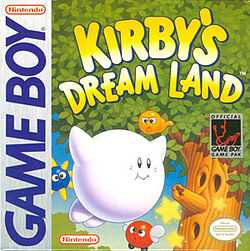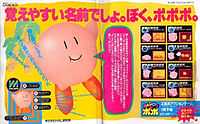Kirby's Dream Land
| Kirby's Dream Land | |
|---|---|
 North American box art | |
| Developer(s) | HAL Laboratory |
| Publisher(s) | Nintendo |
| Director(s) | Masahiro Sakurai |
| Producer(s) | Makoto Kanai Satoru Iwata (uncredited) Shigeru Miyamoto (uncredited) |
| Composer(s) | Jun Ishikawa |
| Series | Kirby |
| Platform(s) | Game Boy, 3DS Virtual Console |
| Release date(s) | Game Boy3DS Virtual Console |
| Genre(s) | Platforming |
| Mode(s) | Single-player |
Kirby's Dream Land (星のカービィ Hoshi no Kābī, "Kirby of the Stars"), is a 1992 third party developed platforming video game developed by HAL Laboratory and published by Nintendo for the Game Boy handheld video game console. It was first released in Japan, and was later released in North America. It is both the first video game in the Kirby series and the debut of the Kirby character. Kirby's Dream Land was designed by Masahiro Sakurai, at HAL Laboratory who intended for Kirby's Dream Land to be a simple game that could be played by beginning gamers. As the inaugural Kirby title, Kirby's Dream Land created many conventions that would appear in later games in the series, including Kirby's basic moves. However, Kirby's trademark "copy" ability would not appear until Kirby's Adventure, released less than one year later. Kirby's Dream Land was re-released for the 3DS's Virtual Console service in 2011. It is also one of the games included in Kirby's Dream Collection, which was released to celebrate Kirby's 20th anniversary.
Gameplay

The gluttonous King Dedede has stolen all of the food from the inhabitants of Dream Land for a midnight feast, so Kirby, a resident of Dream Land, goes to retrieve the food and stop Dedede. Kirby's Dream Land plays like other platformers of the 8-bit and 16-bit era of video games: Kirby must use various natural abilities and occasionally external abilities or items while heading toward the goal at the end of each level. Like many 1980s-era platformers, the player can accumulate points, with an extra life granted when the player has enough points. However, because Kirby lacks a save function, scores are not recorded. Also, there are no save files, so the player has to start over again when the Game Boy is turned off, if the player chooses to return to the title screen after a Game Over, or if the player resets the game. All levels are played on a two-dimensional plane, letting Kirby move only left, right, up, and down. Kirby can walk, jump, and fly. Kirby can also inhale objects and enemies, swallowing them or spitting them out as projectiles.
Development

Kirby's Dream Land was developed by Masahiro Sakurai of HAL Laboratory. Kirby was a dummy character that the developers used until they could define a more sophisticated image. The designers grew to like Kirby so much that they decided to keep him instead of using a more advanced character. He was originally named Popopo (ポポポ), and Kirby's Dream Land was titled Twinkle Popo (ティンクル・ポポ). Eventually, he was renamed Kirby and the game was renamed Kirby of the Stars. During the development of what was then referred to as Twinkle Popopo, Popopo/Kirby's colour had not been decided upon. Masahiro Sakurai wanted him to be pink, while Shigeru Miyamoto felt that he should be yellow. Eventually, Nintendo decided to make him pink. Although pink is still Kirby's main colour, later games have shown Kirby in a wide variety of colours, including yellow. When Kirby of the Stars was first released in Japan, it featured Kirby in pinkscale. However, Nintendo of America designed the North American box art and advertisements with a white Kirby based on the game's grey-scale visuals.[1]
The visuals are presented in two dimensions using pixelated sprites and environments. They are in black and white, like all Game Boy video games. The grey-scale visuals caused confusion with the North American box art, resulting in Nintendo of America presenting Kirby as being white.[1] The music was composed by Jun Ishikawa. He was the only composer for this game,[2] and has been a regular composer in the Kirby series. His most recent work was on Kirby Super Star Ultra in 2008.[3] Certain songs were also reused in the Super Smash Bros. series as the background music of the Dream Land stage in Super Smash Bros.[4] and the Green Greens stage in Super Smash Bros. Melee.[5]
Reception and legacy
Kirby's Dream Land has received generally mixed to positive reception. It holds an aggregate score of 64.83% on Game Rankings with six reviews, making it the 13th best Game Boy game and the 7,279th best video game.[6] By May 28, 1995 Kirby's Dream Land had sold 1.3 million copies, making it the fourth biggest Game Boy release to date.[7] To date, it has sold in excess of 5 million copies worldwide; Gamasutra cited its new style of gameplay for its success. At the time, it was HAL Laboratory's most successful game.[8] Gamasutra's Osamu Inoue attributed the game's success to Satoru Iwata, formerly an employee of HAL Laboratory, who Inoue comments has a "simple-minded passion for creating games".[8] Game Informer's Ben Reeves called it the 14th best Game Boy game and felt that it was a relaxing game.[9] Author Wendy Despain used Kirby's Dream Land's plot as an example of how early platform games' plots, which she collectively described as "the main character needing to reach a villain to put right a wrong."[10] Humongous Life's Jonathan Wahlgren called it a strong game, but felt it to be "too elementary".[11] GamesRadar's Brett Elston did an article on its music, specifically giving praise to the final boss music, stating that it is the "only song in the original Kirby that had a sense of challenge or conflict instead of skipping through a field of floating cakes."[12] Nadia Oxford of 1UP.com praised it for its unique platforming mechanics, describing it as the start of a "gluttonous legend".[13] Allgame's Joshua Crystal called it a "great game for beginner players and ones that enjoy a fun, but short, experience.".[14] Critics said: Kirby's Dream Land is a great game, but it would have been much better if it had a couple of more stages.
In an article detailing various Kirby series video games, IGN stated that it was a decent platformer, but also very basic compared to later titles.[15] IGN's Lucas M. Thomas and Craig Harris included Kirby's Dream Land in their wishlist for a hypothetical "Virtual Console" for the Nintendo 3DS, commenting that its inclusion would be based on nostalgia rather than it feeling "new and sensational". They also added that original characters like Kirby were the stars of the Game Boy rather than established characters such as Link, Mario, Samus Aran, and Pit.[16] They would again praise Kirby's Dream Land for being an original game in their "History of the Game Boy" article, adding that while "attitude" was common in new platforming mascots, Kirby was cheery and adorable, while the game featured "breezy, casual gameplay and lighthearted atmosphere".[17] GameSpy's Gerald Villoria, Brian Altano, and Ryan Scott called it "basic" compared to later titles in the series, adding that it lacked a sense of danger because Kirby could fly.[18] Nintendo Power editors George and Bob shared roughly similar opinions of the game; George stated that it is a really fun game, owing its quality to its excellent play control and well thought out concept, while Bob stated that it is deceptively simple looking, when it in fact features a decent challenge for more experienced gamers.[19] GamesRadar listed Kirby's Dream Land and its sequel as two of the titles they want in the 3DS Virtual Console.[20]
Kirby's Dream Land has since spawned dozens of sequels across more than a half-dozen video game consoles. The first direct sequel was Kirby's Adventure, which was released on the Nintendo Entertainment System console. It introduced the ability to steal powers from enemies, an ability which has been used in the majority of games following it.[21] It was followed by two more Dream Land titles: Kirby's Dream Land 2 and Kirby's Dream Land 3.[22][23] The series has featured several spin-offs, including the racing game Kirby Air Ride and pinball game Kirby's Pinball Land.[24][25] Several other games have featured Kirby's Dream Land in one way or the other. In Super Smash Bros. and Super Smash Bros. Melee, a stage called "Dream Land" appears, taking elements from Dream Land.[26]
See also
References
- ↑ 1.0 1.1 "Welcome to Kirby's Rainbow Resort! - Creation". Gamespy.com. Archived from the original on April 14, 2009. Retrieved 2007-03-06.
- ↑ "Kirby's Dream Land for Game Boy - MobyGames". MobyGames.com. Retrieved 2007-06-24.
- ↑ "MobyGames - Jun Ishikawa". MobyGames.com. Retrieved 2007-03-06.
- ↑ "'Kirby Series'". NinDB. Retrieved 2008-01-09.
- ↑ "Super Smash Bros. Melee Orchestra OST". phdreams.com. Retrieved 2007-03-17.
- ↑ "Kirby's Dream Land for Game Boy". GameRankings. Retrieved 2010-10-09.
- ↑ "Atlanta News, Sports, Atlanta Weather, Business News | ajc.com". Nl.newsbank.com. 1995-05-28. Retrieved 2010-10-09.
- ↑ 8.0 8.1 "Features - Iwata and Miyamoto: Business Ascetics - An Excerpt from Humoungous". Gamasutra. Retrieved 2010-10-09.
- ↑ Reeves, Ben (2011-06-24). "The 25 Best Game Boy Games Of All Time". Game Informer. Retrieved 2013-12-06.
- ↑ Writing for video game genres: from ... - Google Books. Books.google.com. Retrieved 2010-10-09.
- ↑ "Kirby's Dream Land (Retro) review". Retro.humongous.com. 2009-08-03. Retrieved 2010-10-09.
- ↑ "Game music of the day: Kirby's Dream Land". GamesRadar. 2010-06-21. Retrieved 2010-10-09.
- ↑ "Complete History of Kirby". 1up.com. Retrieved 2010-10-09.
- ↑ Crystal, Joshua (2010-10-03). "Kirby's Dream Land - Review". allgame. Retrieved 2010-10-09.
- ↑ "Kirby Compared". IGN.com. 2008-09-26. Retrieved 2008-10-01.
- ↑ Thomas, Lucas M. (2009-08-17). "The DSi Virtual Console Wishlist - DS Feature at IGN". Ds.ign.com. Retrieved 2010-10-09.
- ↑ Fahs, Travis (2010-07-07). "IGN Presents the History of Game Boy - Retro Feature at IGN". Retro.ign.com. Retrieved 2010-10-09.
- ↑ "GameSpy: Game Boy 20th Anniversary Celebration, Day 1: Then and Now - Page 1". Ds.gamespy.com. Retrieved 2010-10-09.
- ↑ "Nintendo Power". Gamespy.com. Retrieved 2007-03-26.
- ↑ "12 classic Game Boy and Game Boy Color games we want on 3DS". GamesRadar. Jan 19, 2010. Retrieved 2011-01-27.
- ↑ "27. Kirby's Adventure - Top 100 NES Games". IGN. Retrieved 2013-08-30.
- ↑ "Kirby's Dream Land 2 for Game Boy from". 1UP. Retrieved 2013-08-30.
- ↑ "Kirby's Dream Land 3 - Wii - IGN". Wii.ign.com. 2009-01-05. Retrieved 2013-08-30.
- ↑ "Kirby Air Ride - GameCube - IGN". Cube.ign.com. 2004-03-04. Retrieved 2013-08-30.
- ↑ "Kirby's Pinball Land - Game Boy - IGN". Gameboy.ign.com. Retrieved 2013-08-30.
- ↑ "Super Smash Bros. Melee - cube - Walkthrough and Guide - Page 34 - GameSpy". Cube.gamespy.com. 2002-01-20. Retrieved 2013-08-30.
External links
| ||||||||||||||